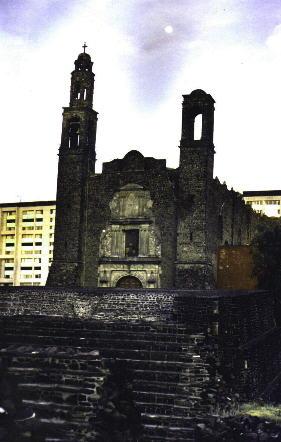This page is mirrored with permission from Peter Rashkin,
of SPANISH DAGGER PUBLICATIONS

They no longer had nor could find any arrows, javelins or stones with which to attack us, and our allies fighting with us were armed with swords and bucklers, and slaughtered so many of them on land and in the water that more than forty thousand were killed or taken that day. So loud was the wailing of the women and children that there was not one man among us whose heart did not bleed at the sound…
–Cortés
Two thirds of the conquistadors perished in the flight from Mexico. All the rest were wounded, sick and disheartened as they dragged themselves to Tlaxcala. Most of them wanted nothing more than to go home, or at the very least back to Vera Cruz to wait for reinforcements…LOTS of reinforcements.
Cortés saw it differently. Not only had he staked everything he had or could borrow on the enterprise, but he had completely compromised himself. He knew that in defeat he would be considered a traitor to Spain, but that in success he would be its hero. And his Tlaxcalan allies were still royal. So he argued, cajoled, bullied and coerced his troops, and they began preparing for the siege of Mexico. By happy coincidence, reinforcements and supplies were beginning to trickle into Villa Rica and from there to the interior.
He started by subduing the people of central Mexico. They were legally subject to Emperor Carlos, he argued, and if they were rebellious it was his right and duty to oppose and punish them. He still preferred diplomacy, and if a city would join him in opposition to Mexico, their past opposition might be forgiven. If they resisted and were crushed, the punishment was slavery. Díaz complains that the rank and file were made to turn in their captured slave women for branding, and that they never got the good ones back…they always went to the officers.
At the same time that Cortés was securing his position in and around the Valley of Mexico, he was having thirteen sloops built at Tlaxcala, using hardware salvaged from his original ships. When these were launched at Texcoco, they would serve as his navy in the ultimate struggle. At the end of the year, his warships ready and important positions in the valley secured, the siege of Mexico began.
The siege lasted seven months. Tenochtitlan was cut off from external food supplies; the aqueduct that brought water to the city from Chapultepec was destroyed. The Spaniards and their allies fought their way across the causeways, were driven back and again advanced. When they got the city, every rooftop was an enemy stronghold. Most of the city was destroyed, because the only way for Cortés to hold a sector was to raze it. The Aztecs, hungry, thirsty and stricken with smallpox, refused to give up. By August they were confined to the formerly great market precinct of Tlatelolco.
With Cortés closing in, Cuauhtémoc decided to try to escape to the mainland where he could keep up the struggle guerrilla fashion. He was captured, effectively ending the Aztec resistance.
Tlatelolco today is the Plaza of the Three Cultures. It contains the excavated ruins of the great pyramid, second largest in the city, and one of the oldest colonial churches, dedicated to Santiago (Saint James), patron saint of the conquistadors, who would charge into battle yelling “Santiago, and at ’em!” And it is surrounded by modern office buildings and government-built housing projects named for important dates in Mexican history.
There are stelae, inscribed stone monuments. One describes the pre-Columbian history of Tlatelolco, which was an independent Aztec city until it was absorbed by Tenochtitlan in the 15th century. The second (shown on the next panel) tells of Cuauhtémoc’s defeat. The third, erected in 1993, concerns the events of Oct. 2, 1968.
This was Mexico’s Kent State, except that the government killed about 100 times more students. The exact number is disputed. You can find holes in the old church wall made by machine gun bullets. Some of them are circled in chalk. A friend told me that his uncle was singing in a choir in the church the night of the massacre, and that many people rushed into the church to escape the hail of bullets.
The monument lists the names of the known victims and chastises the press for its failure to report honestly on the event. To me, an argumentative monument in a public square seems to be a particularly free and vigorous form of expression, especially in a country that is often criticized for its lack of democracy.
August 13, 1521
Heroically defended by Cuauhtémoc, Tlatelolco fell to the power of Hernán Cortés.
It was neither a triumph nor a defeat.
It was the painful birth of the mestizo nation that is the Mexico of today.
–text of monument at Tlatelolco

